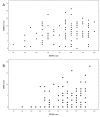The frequency of bowel and bladder problems in multiple sclerosis and its relation to fatigue: A single centre experience
- PMID: 31536557
- PMCID: PMC6752850
- DOI: 10.1371/journal.pone.0222731
The frequency of bowel and bladder problems in multiple sclerosis and its relation to fatigue: A single centre experience
Abstract
Background: Bowel and bladder problems affect more than 50% of people with Multiple Sclerosis (MS). These problems have a large impact on quality of life and place a significant burden on health systems.
Objectives: This study aimed to ascertain the frequency of bladder and bowel problems in a select Australian MS cohort and to investigate the relationships between level of disability, bladder and bowel problems, and fatigue.
Methods: Questionnaires on the nature and severity of MS symptoms were distributed to clients attending an Australian MS centre. Log-binomial regression and multiple linear regression models were used to investigate relationships between disability, fatigue, and bladder and bowel problems.
Results and conclusions: Of 167 questionnaires distributed, 136 were completed. Bladder problems were reported by 87 (74.4%) respondents, whilst 66 (48.9%) experienced functional constipation and 43 (31.9%) faecal incontinence. This frequency in our select Australian MS population is similar to that reported globally. There was a significant correlation between level of disability and: bladder problems (p = 0.015), faecal incontinence (p = 0.001), fatigue (p<0.001) and constipation (p = 0.016, relative risk: 1.16). Further investigation into the causal relationships between various MS symptoms may be beneficial in the development of novel therapeutic strategies for people with MS.
Conflict of interest statement
PH and TJ are employees of MS Limited. This does not alter our adherence to PLOS ONE policies on sharing data and materials.
Figures



Similar articles
-
Prevalence of bowel dysfunction in patients with multiple sclerosis and bladder dysfunction.J Neurol. 1995 Jan;242(2):105-8. doi: 10.1007/BF00887825. J Neurol. 1995. PMID: 7707085
-
Multiple sclerosis: prevalence and factors impacting bladder and bowel function in an Australian community cohort.Disabil Rehabil. 2009;31(19):1567-76. doi: 10.1080/09638280802639566. Disabil Rehabil. 2009. PMID: 19848557
-
Treatment satisfaction and bothersome bladder, bowel, sexual symptoms in multiple sclerosis.Mult Scler Relat Disord. 2018 Feb;20:16-21. doi: 10.1016/j.msard.2017.12.006. Epub 2017 Dec 14. Mult Scler Relat Disord. 2018. PMID: 29275057
-
Pathophysiology and management of bowel dysfunction in multiple sclerosis.Eur J Gastroenterol Hepatol. 2001 Apr;13(4):441-8. doi: 10.1097/00042737-200104000-00025. Eur J Gastroenterol Hepatol. 2001. PMID: 11338078 Review.
-
Bladder, bowel and sexual dysfunction in multiple sclerosis: management strategies.Drugs. 2003;63(2):153-66. doi: 10.2165/00003495-200363020-00003. Drugs. 2003. PMID: 12515563 Review.
Cited by
-
Neurogenic Lower Urinary Tract Dysfunction in Asymptomatic Patients with Multiple Sclerosis.Biomedicines. 2022 Dec 15;10(12):3260. doi: 10.3390/biomedicines10123260. Biomedicines. 2022. PMID: 36552016 Free PMC article.
-
Risk of serious infections in multiple sclerosis patients by disease course and disability status: Results from a Swedish register-based study.Brain Behav Immun Health. 2022 May 11;22:100470. doi: 10.1016/j.bbih.2022.100470. eCollection 2022 Jul. Brain Behav Immun Health. 2022. PMID: 35607517 Free PMC article.
-
The Prevalence and Impact of Urinary Incontinence on Multiple Sclerosis Patients in Taif City, Saudi Arabia.Cureus. 2024 Mar 26;16(3):e57010. doi: 10.7759/cureus.57010. eCollection 2024 Mar. Cureus. 2024. PMID: 38681390 Free PMC article.
-
Cardiac autonomic function in patients with early multiple sclerosis.Clin Auton Res. 2021 Aug;31(4):553-562. doi: 10.1007/s10286-021-00790-w. Epub 2021 Mar 4. Clin Auton Res. 2021. PMID: 33665745
-
Prevalence of stress urinary incontinence and urge urinary incontinence in multiples sclerosis patients: a systematic review and meta-analysis.Neurol Sci. 2024 Sep;45(9):4197-4210. doi: 10.1007/s10072-024-07570-0. Epub 2024 May 6. Neurol Sci. 2024. PMID: 38710988
References
-
- Multiple Sclerosis International Federation. Atlas of MS 2013: mapping multiple sclerosis around the world. Mult Scler Int Fed. 2013:1–28.
-
- Multiple Sclerosis Specialist Nurses in Australia 2017 [Internet]. Sydney: MS Australia; 2017 [cited 2018 Aug 12]. Available from: https://www.msaustralia.org.au/sites/default/files/MSA%20MS%20Specialist....
-
- Compston A, Coles A. Multiple sclerosis. The Lancet. 2008;372(9648):1502–17. - PubMed
-
- Olek MJ, Narayan RN, Frohman EM, Frohman TC. Clinical features of multiple sclerosis in adults. In: González-Scarano F, editor. UpToDate. UpToDate, Waltham, MA. (Accessed on April 2, 2018)2018.
Publication types
MeSH terms
LinkOut - more resources
Full Text Sources
Medical

